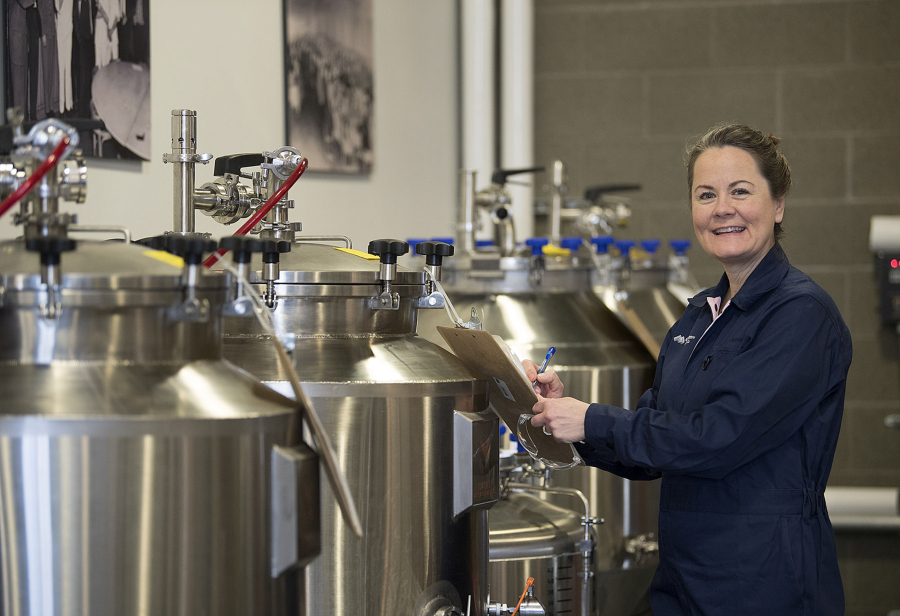Teri Fahrendorf likes to say she would be jealous of her job if she didn’t have it.
The 56-year-old is the manager of Great Western Malting Co.’s Malt Innovation Center — a stainless steel beer lab of sorts at the company’s location at the Port of Vancouver. There, she tests new batches of malt and the beer they yield.
A Wisconsin native, she wears a long-sleeve pink shirt and a thin, black vest in the steely, cold port. The outfit represents her other job: the founder of the Pink Boots Society, an organization for women in brewing.
She speaks in the famously aw-shucks Midwestern pleasantries — salted with a cuss word here or there — and regularly drifts into storytelling. With 30 years in the industry, she has a lot of stories.
During an aside about an unreliable former co-worker, Fahrendorf says he “didn’t know his righty-tighty from his lefty-loosey!”
But she knows hers.
“I never do anything half-assed, I just go –” she said, jutting her hand through the air like a jet.
Fahrendorf, who joined the malt company nearly eight years ago, seemed to be set toward brewing from an early age. For one, she hailed from a German-Catholic family of proud beer drinkers. Crying children were soothed with teaspoons of beer. Everyone, kids included, drank at weddings and family reunions.
For some reason or another, she also had a fascination with yeast by age 10 and baked her own bread. By age 19, she was making her own wine.
Oddly enough, she first became a programmer in San Francisco in the 1980s, writing computer programs for banking software. But she fell in with a group of home brewers called the San Andreas Malts. The group taught her about beer, the interactions of malts, hops, yeasts and temperature — the distinction between ales and doppelbocks.
Even if it meant dropping by her salary by one-third, Fahrendorf wanted to jump into professional brewing.
“I’m a much better brewer than I am a computer programmer,” she said. “Sometimes you gotta do what you gotta do.”
Lager lessons
In 1988, 10 friends from the San Andreas Malts gave up their day jobs and started brewing professionally.
As a woman, Fahrendorf said, she wondered about the physical toll of brewing. Brewing sometimes meant heaving kegs up flights of stairs. She came to see those as problems to be solved.
Around the same time, she started hearing of the brewing program at the Siebel Institute of Technology in Chicago. By happenstance, Fahrendorf’s work flew her to Chicago on business, and she made arrangements to swing by the school. It was a done deal soon after.
“I went back and gave a month’s notice at my job,” Fahrendorf said. “It was funny: I had got employee of the month, and I waited until my name was on that plaque before I gave notice. Even though I’m leaving, I wanted my bloody name on that plaque!”
Going back to school had its own challenges. Tight on cash, Fahrendorf rented a room from a college friend and lived with little more than a sleeping bag with an upside-down box for a desk.
The vogue of microbrewing had not yet struck. Her history with the San Andreas Malts set her apart from her classmates — many of whom were already brewers from corporate breweries like Coors Brewing Company and Molson Brewery.
Fahrendorf even organized tours of other local breweries and helped teach them different styles, she said.
“They thought all beer is yellow lager; they just thought it was a different name,” she said. “They didn’t realize these other things are beer.”
Fahrendorf’s knowledge and gung-ho personality led classmates to elect her the class president.
Pink Boots Society
After graduation, Fahrendorf entrenched herself as a full-time brewmaster. She spent nearly two decades at Steelhead Brewing Company in Eugene, Ore. Then she wanted a change.
“The job wasn’t really growing. I just felt like it was time to move on,” she said.
Her next act in brewing came as a cross-country road trip. She called herself The Road Brewer, visiting 71 breweries and brewing at 38, blogging as she went.
But her calling card was a pair of screaming pink boots she wore.
“It became my trademark on this trip. People say ‘Hi Teri’ and I’d say, ‘How’d ya know it’s me?’ and they would say, ‘Oh, they told me you’d be wearing pink boots. I saw you a mile away,'” she said.
At the breweries, she was often paired with other female brewers. Many were unaware of other women in the industry. Fahrendorf saw an opportunity to brew all over the country as a chance to track down and unite other female brewers, too. She said her “mother hen” came out.
“It was really clear that (they) needed mentors in a way that I never knew that I needed it — I sure could have used it, in hindsight,” she said. “At first, they said to me, ‘Wow, I never met another woman brewer. I thought I was the only one; now I’m meeting you. How many of us are there, Teri?'”
Zigzagging brewery to brewery, Fahrendorf collected names and contact information of female brewers. She followed rumors to one town or another. Once found, they asked the same questions — “How many of us are there?” — in the hopes of networking. The list eventually became a full-blown organization: The Pink Boots Society.
The Pink Boots Society’s membership is comprised of women in some part of the beer industry, be it brewing or beer journalism. It has since become an international nonprofit with about 2,000 members. Fahrendorf’s involvement faded over time, but the organization is going strong.
In forming the organization, Fahrendrof said she hoped the beer industry would see women as equals in the industry. It does no good to dwell on the past, she said, only to make sure women are included in the future.
“Say a young woman comes to me and complains that so-and-so didn’t hire her. I’m like, ‘Go get a job somewhere else. Make them sorry they didn’t hire you,'” she said. “Be amazing. Be great.”




